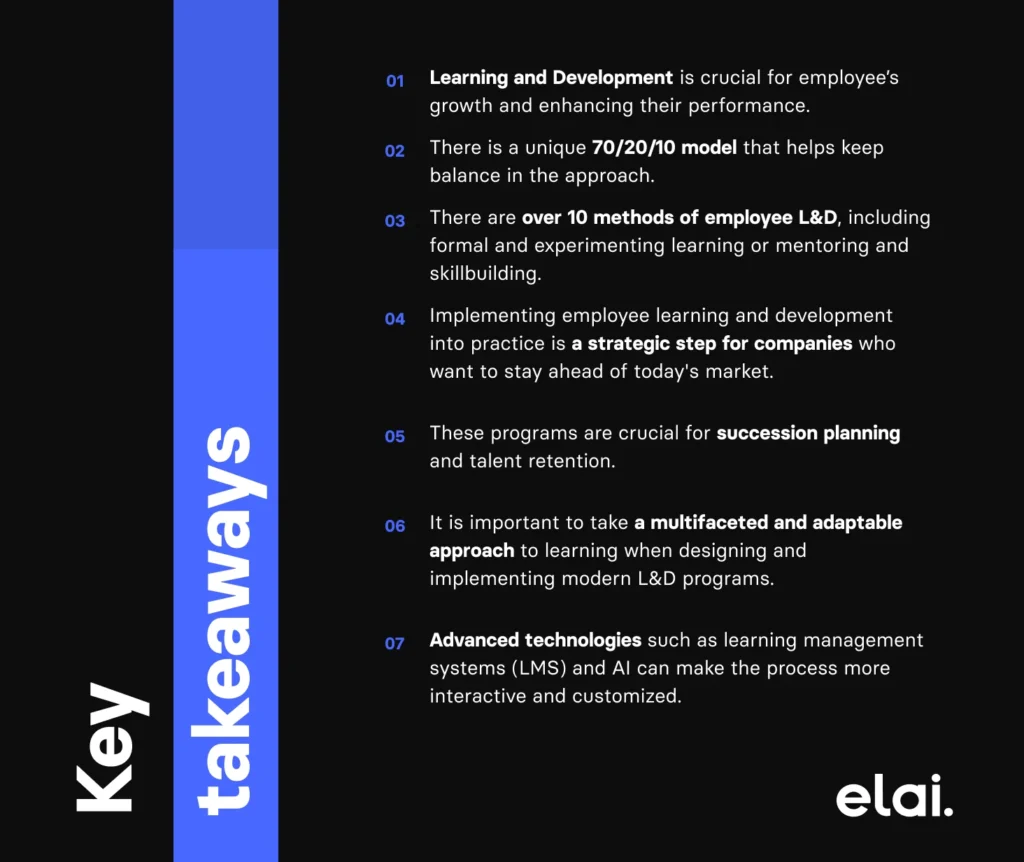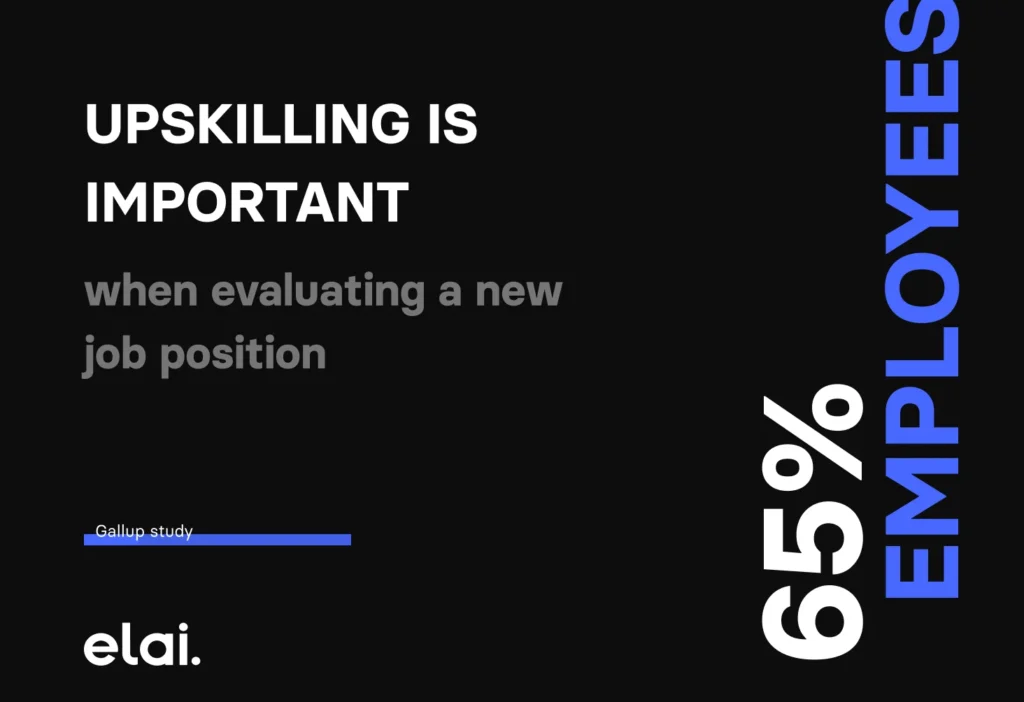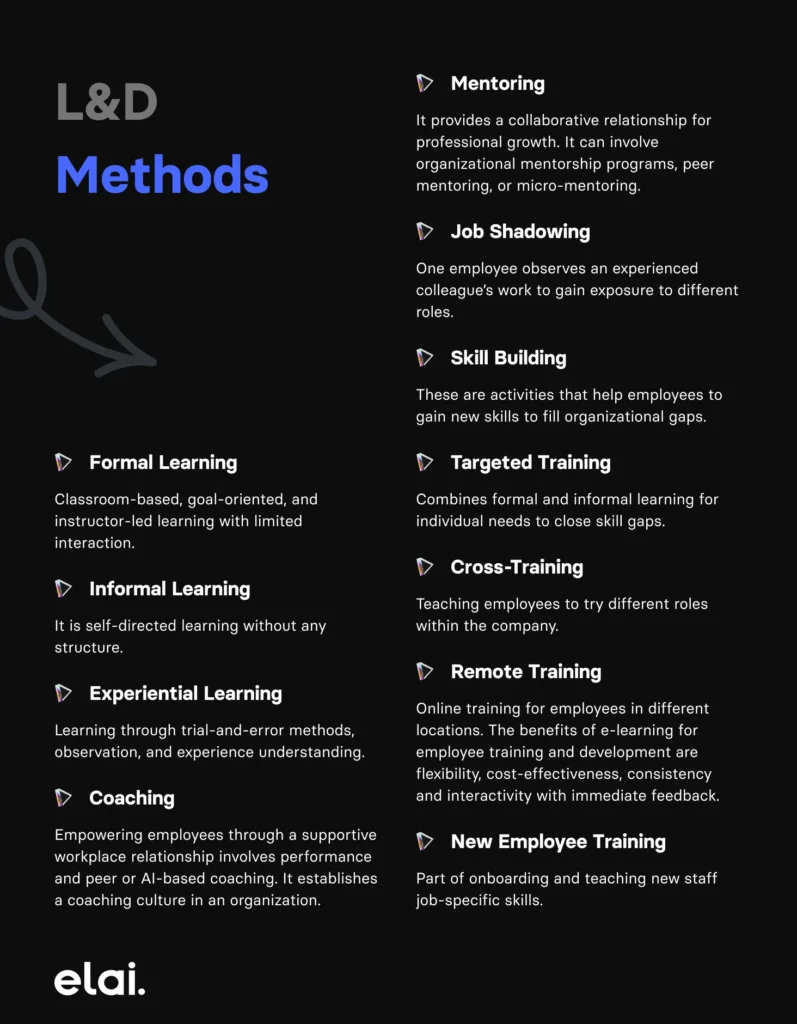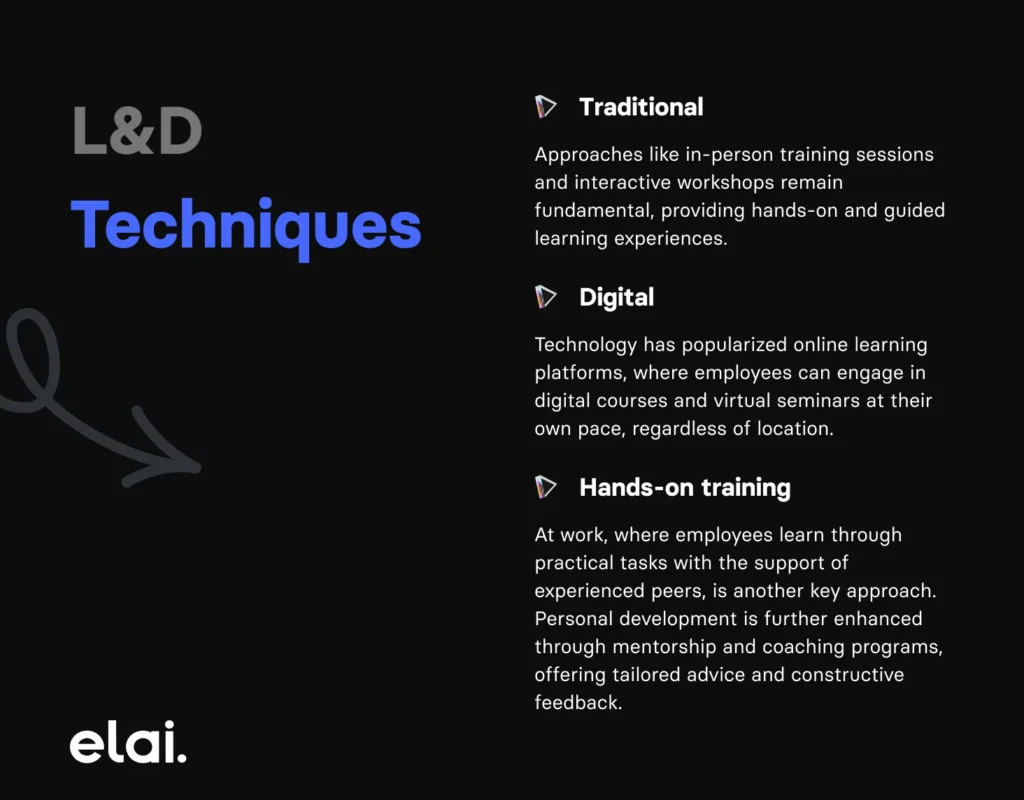Key takeaways:
- Learning and Development is crucial for employees’ growth and enhancing their performance.
- There is a unique 70/20/10 model that helps keep balance in the approach.
- There are over 10 methods of employee L&D, including formal and experimenting learning or mentoring and skillbuilding.
- Implementing employee learning and development into practice is a strategic step for companies who want to stay ahead of today’s market.
- These programs are crucial for succession planning and talent retention.
- It is important to take a multifaceted and adaptable approach to learning when designing and implementing modern L&D programs.
- Advanced technologies such as learning management systems (LMS) and AI can make the process more interactive and customized.

Reasons behind implementing employee learning and development
Implementing employee learning and development (L&D) into practice is a strategic step for companies who want to stay ahead of today’s market. They understand the need to keep their staff updated on the latest technical developments and business trends, which is one of the main causes for implementing it. Personnel must regularly refresh their skill set to remain productive and relevant in a world where new technologies and methods are developing every minute.
L&D programs give workers the skills and information they need to be competent. Staff also start understanding their industry better, which means they are ready for emerging trends. Constant upskilling gives businesses the opportunity to stay at the forefront of their respective fields and respond faster to any changes in the market.
Another important effect of employee learning and development is job satisfaction and motivation for a team to grow. And it’s statistically proven! A recent study by Gallup showed that 65% of employees believe upskilling is important when they evaluate their new job position. Workers feel more appreciated and motivated when they are given the chance to train and grow. This is especially true for the younger population, whose job choices are based more on personal development.

Companies care about their staff’s professional and personal growth, by investing time and money in L&D. What are the benefits of this investment? First of all, a more favorable company culture. Secondly, decreased employee attrition and enhanced employee loyalty. Workers will more likely be devoted and perform excellent work when they see that their employer is interested in their professional growth. This helps the company succeed as a whole.
Finally, employee learning and development programs are crucial when it comes to planning succession and talent retention. Retaining top talent is as important as trying to attract fresh ones. Employees who have L&D programs have a better chance of being promoted and advancing their careers within the company rather than looking for other possibilities.
This is especially crucial to creating a strong pool of future leaders.
Methods and key techniques
What is L&D? Learning and development is a field of self-development and studying focused on ongoing education and skill improvement of the employees in an organization. It is a part of human resources and organizational development. The main aim at L&D is to foster growth at both individual and organizational levels. In modern life e learning and employee development are the most engaging way of studying and self-improvement.
There is a 70/20/10 Model for employee learning and development. This approach to organizational learning suggests that 70% of learning comes from informal work-based activities, 20% from developmental relationships, and 10% from formal coursework and training.
Learning and development methods include:
- Formal Learning: Classroom-based, goal-oriented, and instructor-led learning with limited interaction.
- Informal Learning: It is self-directed learning without any structure.
- Experiential Learning: Learning through trial-and-error methods, observation, and experience understanding.
- Coaching: Empowering employees through a supportive workplace relationship involves performance and peer or AI-based coaching. It establishes a coaching culture in an organization.
- Mentoring: It provides a collaborative relationship for professional growth. It can involve organizational mentorship programs, peer mentoring, or micro-mentoring.
- Job Shadowing: One employee observes an experienced colleague’s work to gain exposure to different roles.
- Skill Building: These are activities that help employees to gain new skills to fill organizational gaps.
- Targeted Training: Combines formal and informal learning for individual needs to close skill gaps.
- Cross-Training: Teaching employees to try different roles within the company.
- Remote Training: Online training for employees in different locations. The benefits of e learning for employee training and development are flexibility, cost-effectiveness, consistency and interactivity with immediate feedback.
- New Employee Training: Part of onboarding and teaching new staff job-specific skills.

Various techniques are employed in Learning and Development (L&D) to boost employee expertise and knowledge in the workplace:
Traditional approaches like in-person training sessions and interactive workshops remain fundamental, providing hands-on and guided learning experiences.
Digital technology has popularized online learning platforms, where employees can engage in digital courses and virtual seminars at their own pace, regardless of location.
Hands-on training at work, where employees learn through practical tasks with the support of experienced peers, is another key approach. Personal development is further enhanced through mentorship and coaching programs, offering tailored advice and constructive feedback.
L&D strategies now integrate elements like gamification and immersive virtual reality experiences, accommodating different learning styles and enhancing engagement to make the learning process more dynamic and appealing. These varied approaches are central to cultivating an environment of ongoing organizational learning and development.

Ensuring the success of L&D initiatives
Learning and Development (L&D) initiatives should be implemented strategically. Starting with a comprehensive needs analysis is essential. This step includes estimating the existing skill level of the organization’s employees and identifying the knowledge areas that need to be enhanced. The challenge is determining exactly where L&D efforts should be directed to close these gaps. This process should be aligned with the company’s strategic goals. That would help the L&D initiatives to support the overall business objectives. At this stage, getting input from management and employees can ensure that L&D programs are relevant and supportive. The effect is very visible – the growth of the whole organization.
It is important to take a multifaceted and adaptable approach to learning when designing and implementing modern L&D programs. They should combine a lot of methods that we’ve discussed before. It is also crucial to adapt these programs to individual needs and learning styles to enhance engagement and make sure the information is well absorbed. Advanced technologies such as learning management systems (LMS) and AI can make the process more interactive and customized. Moreover, these tools provide valuable data that can be used to continuously improve relevant L&D initiatives.
The final piece of the puzzle is the assessment and application of the skills in the workplace. We need evaluation to determine the effectiveness of the L&D programs. What does it mean? Immediate feedback following training sessions and long-term assessments to detect the impact of individual performance on overall business results. It’s important to look at learning as an ongoing process. Also, an organization should have mechanisms to encourage employees to apply new skills. Regular follow-ups, refresher courses, and a workplace culture that values continuous learning are key.
FAQ
What are the benefits of employee learning and development?
Employee learning and development benefits include enhanced skill sets and knowledge, which lead to improved performance and productivity and increased job satisfaction and retention rates.
How does learning and development contribute to employee engagement?
Learning and development contribute to employee engagement by fostering a sense of value and investment in employees, encouraging their growth and development, and making them feel more connected and committed to their organization.
What is employee learning and development?
Employee learning and development refer to the continuous process of enhancing an employee’s skills, knowledge, and competencies through various training programs, workshops, and educational opportunities, aimed at both personal and professional growth within the organization.

